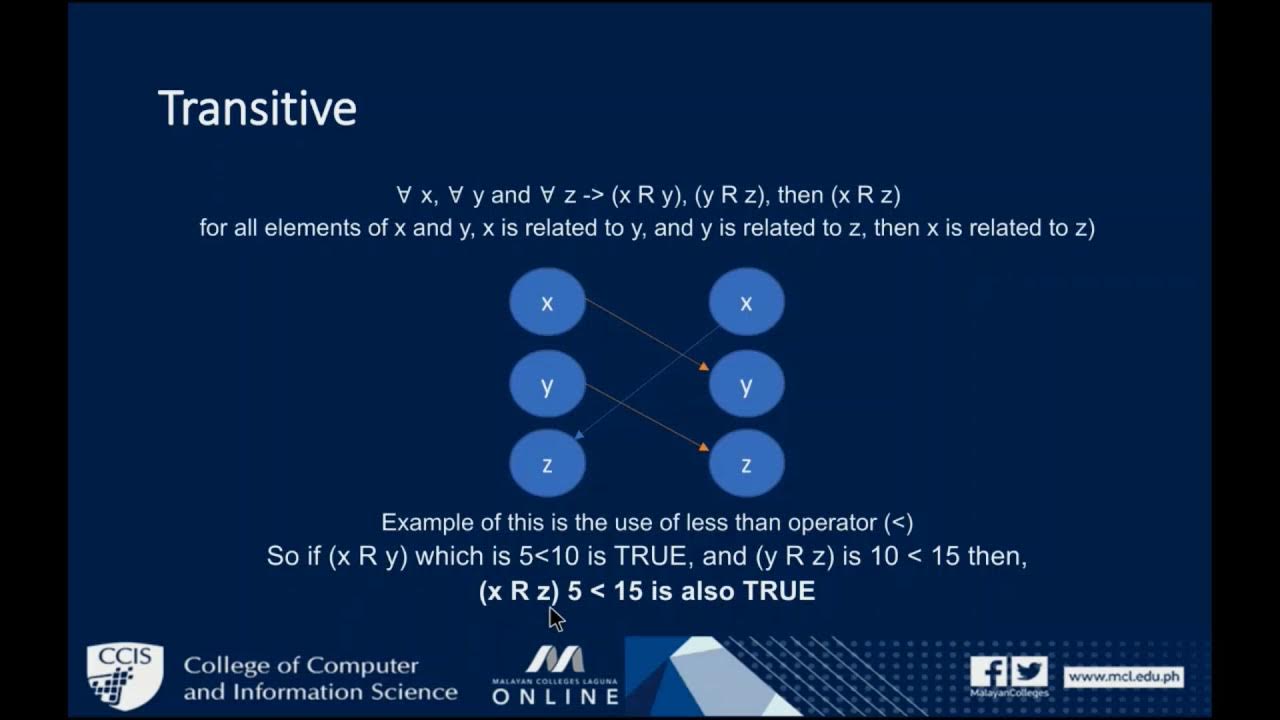Module 2 Lesson 1 Characteristics of Mathematical Language
Summary
TLDRThis module introduces the concept of mathematics as a precise, concise, and powerful language. It explains the characteristics of mathematical symbols, operations, and expressions, and their role in describing complex thoughts in a simplified manner. Key examples, such as the Pythagorean theorem and mathematical definitions like that of a circle, are explored to demonstrate the power of mathematics. The script also compares mathematical language to English, explaining how symbols and rules form complete thoughts in mathematics, much like words and grammar in English. The importance of mathematical expressions, equations, and their simplification is emphasized for better problem-solving.
Takeaways
- 😀 Mathematics is a precise, concise, and powerful language that allows for clear and complex expression of ideas.
- 😀 In mathematics, definitions must be precise and distinct, like the formal definition of a circle in geometry.
- 😀 The Pythagorean Theorem illustrates conciseness in mathematics, where complex relationships are condensed into brief statements.
- 😀 Mathematics enables powerful representations of complex thoughts through symbols, variables, and equations.
- 😀 Mathematical language uses various symbols like the English alphabet, Greek letters, numerals, and other special symbols to form expressions.
- 😀 An expression in mathematics is similar to a noun in English, representing mathematical objects like numbers, sets, and variables.
- 😀 A mathematical sentence, analogous to an English sentence, states a complete thought and can be true or false.
- 😀 Simplifying mathematical expressions involves using fewer symbols and operations, which makes them easier to work with.
- 😀 Mathematical sentences can be true, false, or sometimes true depending on the values of the variables involved.
- 😀 Translating mathematical sentences into symbols and vice versa is a key skill in understanding and communicating mathematical concepts.
- 😀 Understanding the difference between phrases like 'the sum of the squares' and 'the square of the sum' is crucial for accurate mathematical translation.
Q & A
What are the three key characteristics of mathematics as a language?
-Mathematics as a language is precise, concise, and powerful. It makes fine distinctions, allows for brief expression, and can represent complex thoughts effectively.
How is a circle precisely defined in mathematics?
-A circle is defined as the set of points in a plane that are equidistant from a given point, called the center.
What does it mean for mathematical language to be concise?
-Being concise means expressing complex ideas in a brief and clear manner, as demonstrated in the Pythagorean Theorem, which can be stated simply as 'In a right triangle, the square of the length of the hypotenuse is equal to the sum of the squares of the lengths of the other two sides.'
How does mathematical language demonstrate power?
-Mathematical language is powerful because it allows us to express complex concepts in a simple form using symbols and equations, such as representing the Pythagorean Theorem with the equation c² = a² + b².
What are the essential components of mathematical language, and how do they compare to English?
-Mathematical language includes symbols like the English alphabet, numerals, Greek letters, and grouping symbols (parentheses, brackets, braces). It also has its own 'nouns' (expressions), 'verbs' (operations), and 'sentences' (mathematical statements) that convey complete thoughts, similar to English grammar but with its own rules.
What is a mathematical expression, and how does it differ from a sentence?
-A mathematical expression is a combination of numbers, variables, and operators that represents a mathematical object but does not convey a complete thought. A mathematical sentence, on the other hand, expresses a complete idea and can be true or false.
What is an identity equation in mathematics?
-An identity equation is one that is true for all values of the variable involved. For example, the equation x = x is always true, no matter what value is substituted for x.
What does it mean to simplify a mathematical expression?
-To simplify a mathematical expression means to reduce the number of symbols or operations, making it easier to understand or work with. This could involve combining like terms or using more efficient mathematical representations.
How are inequalities and equalities represented in mathematical language?
-Inequalities are represented using symbols like 'greater than' (>) or 'less than' (<), while equalities are represented with the equals sign (=). These symbols are used to form mathematical sentences that express relationships between quantities.
What is the difference between 'the sum of the squares' and 'the square of the sum'?
-The 'sum of the squares' refers to the sum of the squares of individual numbers, expressed as x² + y². The 'square of the sum' refers to squaring the entire sum, written as (x + y)², which expands to x² + 2xy + y².
Outlines

このセクションは有料ユーザー限定です。 アクセスするには、アップグレードをお願いします。
今すぐアップグレードMindmap

このセクションは有料ユーザー限定です。 アクセスするには、アップグレードをお願いします。
今すぐアップグレードKeywords

このセクションは有料ユーザー限定です。 アクセスするには、アップグレードをお願いします。
今すぐアップグレードHighlights

このセクションは有料ユーザー限定です。 アクセスするには、アップグレードをお願いします。
今すぐアップグレードTranscripts

このセクションは有料ユーザー限定です。 アクセスするには、アップグレードをお願いします。
今すぐアップグレード5.0 / 5 (0 votes)






